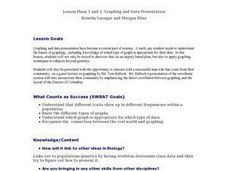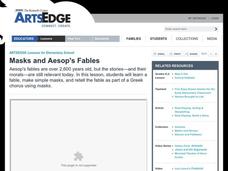Curated OER
Graphing And Data Presentation
Students engage in a study of science and mathematics with the practice of creating graphs. A guest speaker comes to the class to share statistics from the community and the students are shown how he uses the coordinate system in the...
Curated OER
What If?
Second graders read WHAT IF? up to the page that ends "Suddenly, across the field they saw..." and discuss how the animals are feeling. They then discuss their feelings and in pairs discuss a possible ending to the story.
Curated OER
Meiosis
Students study meiosis and how it leads to variation. For this genetic reproduction lesson students complete a lab activity that calculates different genetic possibilities.
Curated OER
Storytelling: Writers' Workshop Learning Center
Evaluating a variety of narrative texts can help build strong writers. Pupils identify plot elements and their relation to personal experience, then apply what they gleaned from the class discussion to create their own narratives.
Curated OER
Persuasive Language
Students read a persuasive story study persuasive language. They then write a 50-word online advertisement for a target audience to try and sell an unusual item to a targeted audience.
Curated OER
Naming a Police Dog
Students examine the role that police dogs do and assist a local police officer to name his police dog. Students participate in an online police station interactive activity, read facts about police dogs, and play an online police dog game.
Curated OER
Gary Paulsen's Canyons, Chapter 9 "The Raid" List-Group-Label
Class members categorize and then label a list of words drawn from "The Raid," chapter nine of Gary Paulsen's Canyons. Individuals explain the rationale for their word groupings.
Curated OER
The Lighter Side of Color
Middle schoolers explore light and color, including how colors are mixed to produce new colors, how light is filtered, and how light is reflected off of surfaces. They read materials provided, complete worksheets, and complete hands-on...
Curated OER
Media Scrapbook
Learners analyze the fundamental issues relating to Canadian parliamentary democracy through the exploration of media and public opinion. A scrapbook is created containing summaries of the work performed.
Alabama Learning Exchange
A Study of Plants
Pupils study and become familiar with parts of a plant by using multi-media resources. They publish a story about plants using a word processing program and include new plant vocabulary that they have learned.
Curated OER
Writing Directions for Mathematical Activities
Fifth graders reorganize comic strips to have them make sense, complete outline and organize their thoughts into outline form to explain directions,
and use that outline to complete their own directions for geometry activities.
Curated OER
ESOL Necessary Skills
Students view flash cards with basic vocabulary pictures on them and match them to the vocabulary words. They cut the pictures apart and glue the words on the back. They play concentration with a partner matching the word with the...
Curated OER
Destination Reading
Students practice reading skills and comprehension through the use of computers and the educational software "Destination Reading" provided by Riverdeep in this self-directed lesson.
Curated OER
A Couple of Kooks and Other Stories About Love
Students read an article about teenage pregnancy and the story, "A Couple of Kooks and Other Stories About Love," making notes about how the pregnant teens are characterized. They then compare and contrast the views of pregnant teens in...
Curated OER
Writing With Dolch
Learners increase their skills in word attack, fluency, and spelling of words and research and find information on topics from the Internet. They then use the Quick Cam with the computer and will increase cooperative skills in small...
Curated OER
Managing My Money
Second graders use The Berenstain Bears' to learn about money management. In this money management lesson, 2nd graders read The Berenstain Bears' Dollars and Sense book and complete the 'Rainy Day' worksheet. Students then discuss the...
Curated OER
Anticipatory Set Picture Walk
The teacher models a Picture Walk by using a "think aloud" method while reading a picture book to the class. On the second day, 3rd graders use a worksheet as a guide for a second picture walk. This time, students complete the "think...
Curated OER
Keeping Track of Our Money
Second graders complete activities to learn how to manage money. In this managing money lesson, 2nd graders read the book How the Second Grade Got $8,205.50 to Visit the Statue of Liberty and complete two related worksheets.
Curated OER
Safeguarding the Rights of the Study Participant
High schoolers write a paper that follow all the conventions of proper English. They create a paper that incorporates the required sections of an informed consent document such as would be used in a real clinical trial. Students...
Curated OER
Masks and Aesop's Fables
Students study and perform Aesop's fables. In this Aesop's fables lesson, students read and/or listen to a number of the famous fables. They make masks based on the characters and perform a fable using the masks. They write about the...
Curated OER
Animal Coverings
Students read a book. In this animal characteristics lesson, students read the book Animal Coverings, answer comprehension questions, and complete a chart where they match animals with their coverings.
Curated OER
A Lesson to Accompany "Benjamin Franklin and the Birth of a Paper Money Economy"
Students examine the role of money in the colonial economy by participating in a trading activity. In this colonial economy lesson plan, students complete an activity to learn about colonial trade and what happens when there is a lack of...
Curated OER
Survivors on the Ocean Ridge
High schoolers discover the uniqueness of deep sea hydrothermal vent organisms through an exploration of the NOAA Galapagos Rift Expedition. They study the genetics and evolution of a shrimp species that lives near the vents then they...
Curated OER
Text Structures in Science Writing
Students recognize that science writing is organized in identifiable patterns called text structures. Understanding and using these different text structures help refine students' abilities to read and write in science.

























